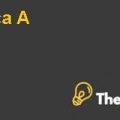
1. (A) Capital Budgeting
Capital budgeting is a process in which the cash inflows and cash outflows are discounted back to identify present value. Such returns are compared with the company’s benchmark and if the returns are increased then the company’s desired benchmark than the investment will be considered as financial viable.
Assumptions in capital budgeting
- Assumption about the cash inflows and cash outflows.
- Assumption that the cost of capital will remain same over the project life.
- Cash inflows and cash outflows occur either at the start or at the end of the project.
(b) Our analysis in Exhibit 1 shows that the Project A has NPV of $915 and Project B has NPV of $794, so the project A is financially viable.
(c) If the project is deferred, then our analysis in Project B shows a NPV of $414.64, so it is not recommended to the company to wait additional two years.
(d) Our analysis in Exhibit 1 shows that the debt to equity ratio of the company is 80%.
(e) Our analysis in Exhibit 1 shows that the Project A has IRR of 131% where as Project B has IRR of 48%.
(f) When the project is initiated, it will incur cost initially and the future returns are achieved over the passage of time. If the project is discontinued when there is bad year then the company will lose the initial investment as well as future earnings. In this situation, the company conducts a critical analysis that whether it should discontinue its project immediately or continue in orders to recover some losses.
2. (a) The required rate of return of Exxon, as shown in Exhibit 2 is 13.38% and we call this required rate of return because it is the desired return which induces any individual to invest in a particular portfolio.
(b) Our analysis in Exhibit 2 shows that the company has the stock value of $19.41 per share.
(c) As evidenced in our analysis in Exhibit 2, if the share price is $28 per share then the required rate of return is 10.5% and the beta will be .095.
(d) Our analysis in Exhibit 2 shows that the company has WACC of 24%.
3. Our analysis in Exhibit 3 shows that if the home is financed through Program 1 then the monthly payments will be $2,906 and if the Program 2 is availed, they will have to pay monthly installment of $9,166. So the individual shall consider adopting Program 1 but on the other hand, the Program 1 requires an initial investment of 120,000.........................................
This is just a sample partial case solution. Please place the order on the website to order your own originally done case solution.













